Download, print and save the reef!
Coral reefs are in acute danger of disappearing due to climate change. An artist and a marine biologist have taken up the challenge of rebuilding the reefs by harnessing the power of 3D printers.
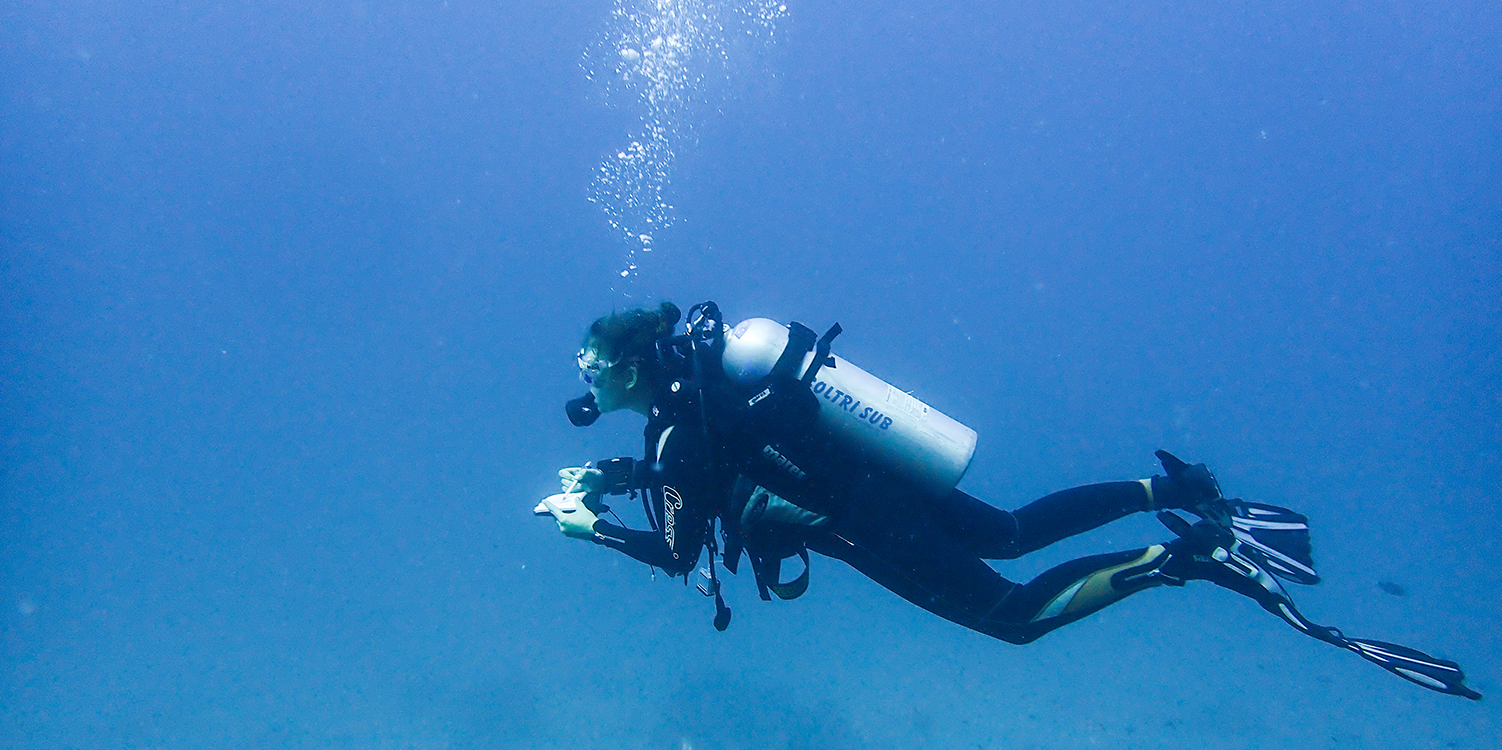
The artist Marie Griesmar never goes diving without an underwater pencil and paper. With a weight belt strapped around her waist, she kneels on the seabed and sketches the shapes of corals, part of an underwater world that has fascinated her since she was a child. “When I look at a coral reef, I feel so incredibly tiny. The reef reminds us how time and space are related, and I find that very moving,” she says. This extraordinary underwater realm is thousands of years old and home to more species than any other underwater habitat. Yet, far out of sight, it is starting to crumble, with rising sea temperatures causing coral bleaching and the death of entire reefs.
How can we combat this in a world where climate change remains out of control? Marie Griesmar has come up with an innovative solution called rrreefs. Working at ETH in collaboration with marine biologist Ulrike Pfreundt, she has developed 3D-printed bricks that can be assembled underwater to create artificial reefs. The surface of the bricks is specially designed to create turbulence in the water, increasing the likelihood that coral larvae will approach the bricks and settle.
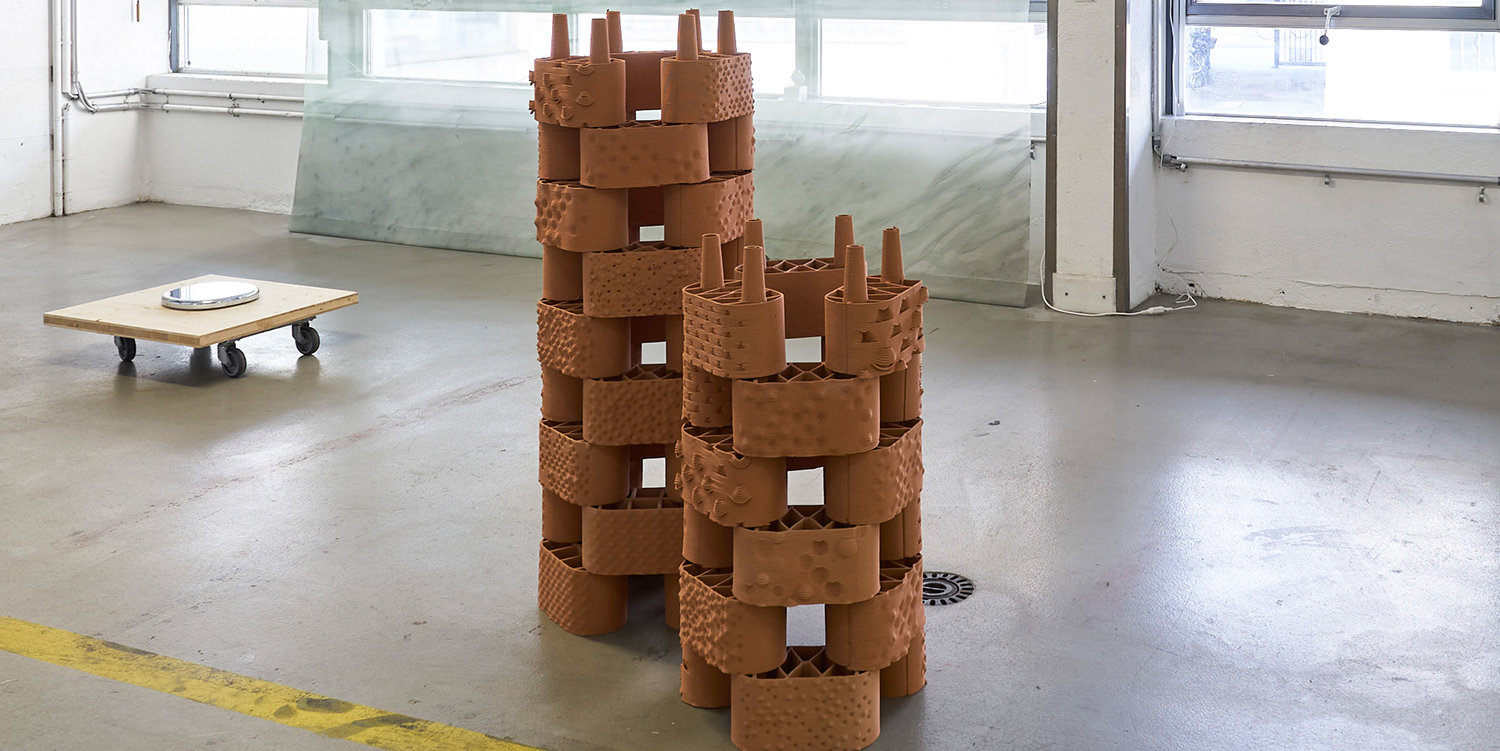
Giving reproduction a helping hand
Most corals only release eggs and sperm cells once a year, typically over the course of a few nights after a full moon. By simultaneously releasing both male and female reproductive cells, the animals maximise the chance of fertilisation. Fertilised eggs develop into elongated coral larvae, which drift away with the current. Those larvae that are fortunate enough to settle in a suitable spot can then grow into a new polyp and start a new coral colony. This is where rrreefs lends a helping hand: “If we can improve the growing conditions for larvae by creating an artificial reef, then we can actually help the corals reproduce,” say Griesmar and Pfreundt. “Coral reproduction has a very low success rate, only about one in a million,” explains Pfreundt. “That was fine in the past, because a coral reef used to be an ecosystem with a long lifespan, but now corals are struggling to adapt and repopulate.” The duo’s plan is to combine natural larval settlement on artificial brick reefs with the method of assisted evolution. Unlike in asexual coral breeding, where parts of a colony are broken off and reattached somewhere else in a process known as “fragging”, assisted evolution involves retrieving eggs and sperm from more resistant corals and artificially fertilising the eggs. This ensures genetic variability, which is crucial when it comes to adapting to warmer ocean temperatures.
The world has already lost half of all coral reefs. One of the key causes is coral bleaching, a process in which rising sea temperatures and water pollution destroy the symbiotic relationship between the coral and a specific type of algae called zooxanthellae. As well as giving corals their colour, zooxanthellae use photosynthesis to produce oxygen and sugar as the corals’ primary food source. “When the water temperature gets too high, scientists suspect this interferes with the algae’s photosynthesis. As a result, the corals start to view them as a parasite and repel them,” says Pfreundt. This causes the coral to bleach and eventually die. The bare calcium skeleton of the coral reef begins to crumble and all that remains is a cemetery choked with algae – and countless sea creatures without a home. Griesmar saw this process for herself on a diving course in the Seychelles: “It was disturbing to see it up close.” The collapse of the foundations on which this ecosystem is based also has major implications for humans, because reefs protect the coastline against erosion and are a key source of income for tourism and fishing.
A stroke of luck
“This problem is a major global challenge that can no longer be solved within the confines of a single discipline,” says Maximiliane Okonnek, Managing Director of the ETH Library Lab. She first met the dedicated young artist during her art residency in San Francisco. They got chatting, and Okonnek mentioned the Innovator Fellowship at the ETH Library Lab. For Griesmar, the timing was perfect. Having already worked on the development of underwater structures with the Reef Genomics Lab in Saudi Arabia, she was planning her next step. “I realised that I would need new technologies like 3D printing to move forward,” she says, explaining what prompted her to apply to ETH. Her collaboration with the ETH Library Lab produced benefits on both sides: Griesmar was able to work with 3D printers, while the Library Lab gained insights into the data and information infrastructure underpinning her methods. Griesmar also used 3D-printing techniques to make models for the Swiss-wide Material Archive network. “3D printing is becoming increasingly important in the scientific community. It’s important for libraries to keep track of relevant infrastructure for sharing information in this field and record how people are using the data and software,” says Okonnek, highlighting how the project dovetails with the goals of the ETH Library Lab.
Griesmar’s successful pitch of her “Beneath the Sea” project led to offers of support for her research into fabricating reef bricks out of clay – both from the Gramazio Kohler Research group at the ETH Chair of Architecture and Digital Fabrication and from Zurich University of the Arts (ZHdK). “First, we had to learn to speak the same language – and I had to learn CAD design and programming. That took a little while,” says Griesmar. Even getting the right blend of clay for 3D printing required a lot of trial and error on Griesmar’s part: “Luckily, clay is easy to recycle. And a local family-run company, Bodmer Ton, gave me a tonne of it to work with.”
Meanwhile, marine biologist Pfreundt was working on the same topic in the same building, though the two women were completely unaware of it at the time. Pfreundt was investigating 3D printing with sand to find out what shapes and structures might help coral larvae settle. “The moment I heard about her work, I realised we should combine our strengths!” says Griesmar. The two researchers share the vision of fabricating a low-cost artificial reef by harnessing new technologies and the support of the local community, with the ultimate aim of regenerating coral reefs.
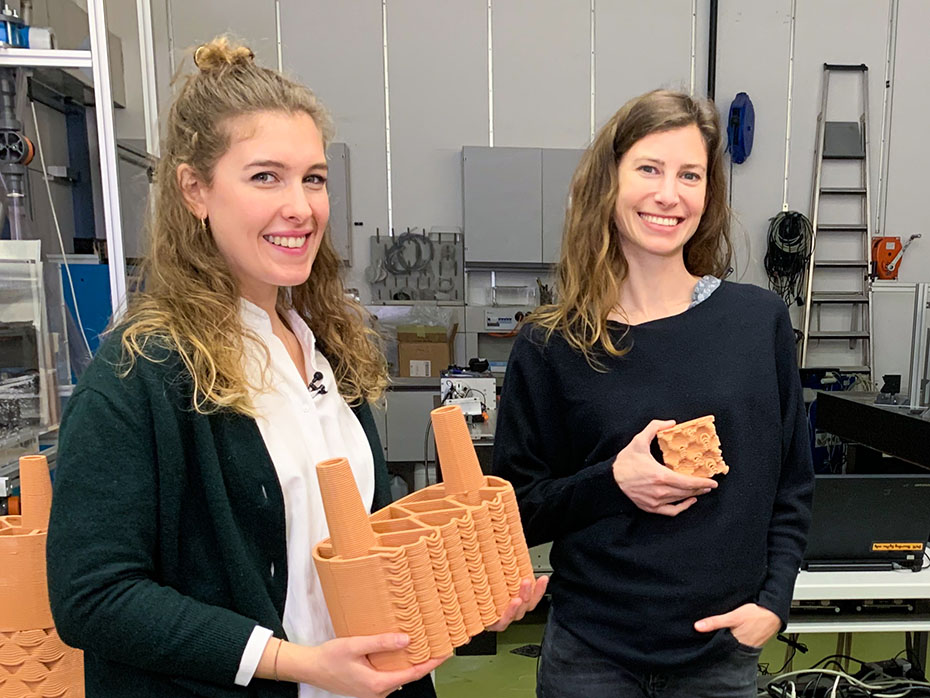
Their overlapping research interests gave rise to the MAS DFAB research thesis “Computational Clay Coral Cities”, which also involved the participation of the Chair of Digital Building Technologies. The thesis provided the framework for two Master’s students from the Department of Architecture to study whether “rapid clay formation” could be used to help build artificial reefs. Rapid clay formation is a method in which robotic arms grab cylindrical pieces of clay and press them together according to defined parameters. The students used data from the Marine Research and High Education Center (MaRHE), while researchers at the Chair of Environmental Fluid Mechanics studied the flow pattern along the artificial reef.
Buoyed by the interdisciplinary findings, Griesmar decided to produce her own structure out of clay using conventional 3D printing. “This method requires less material, and it also means the bricks and printer are easier to transport, which makes it easier to adapt to local conditions,” says the artist. With the help of programmer Jonas Ward Van den Bulcke, she produced building blocks complete with two connectors that make them stackable. Once assembled, they form a robust structure that is able to spread the impact of external forces. “My goal was to create a modular brick system with a playful vibe that is easy to install and appealing to look at,” says Griesmar. Pfreundt’s research results were also incorporated into the process: “Clay has a rough surface that’s perfect for coral larvae. And the sections that protrude a few centimetres from the side of the bricks protect the larvae from sand and the jaws of hungry fish,” says the marine biologist. Samples of Griesmar’s textured clay surfaces are currently hanging in the Indian Ocean, where MaRHE researchers are monitoring the settlement patterns of coral larvae.
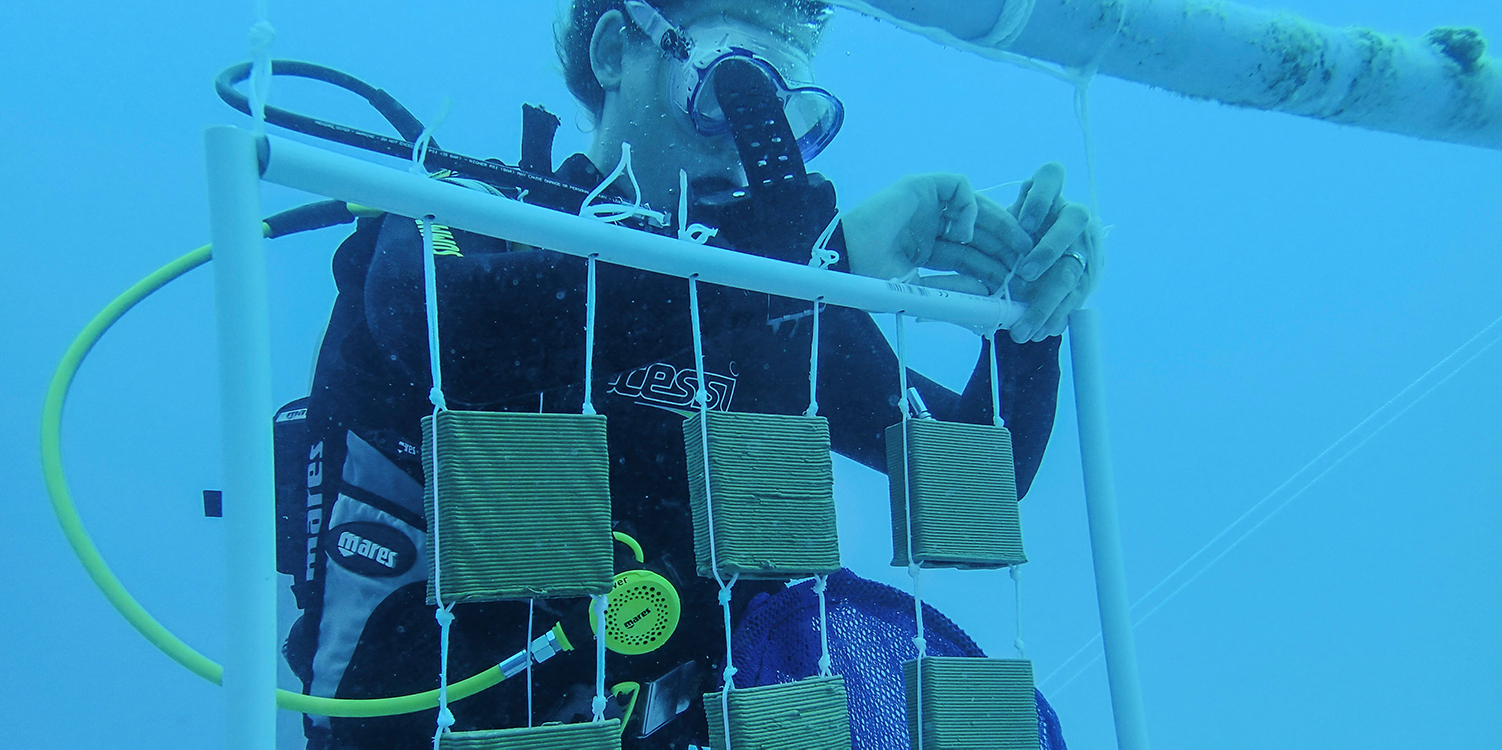
Lego based on science
“The ETH Library Lab helped me find the right people and gave me the methodological framework I needed for my interdisciplinary approach. That was very useful,” says Griesmar. After completing her Fellowship at ETH, she joined forces with Pfreundt to set up an NGO called rrreefs – the three “Rs” stand for rethinking, rebuilding and regenerating reefs. “Our aim is to find a holistic solution that gets local communities involved,” says Griesmar. The basis for this is the rrreef brick system that she developed. The duo is hoping to organise workshops with volunteers to construct two pilot reefs in Colombia and the Maldives. “If I can just get people to experience the majestic beauty of the reef, not to lose hope, and perhaps even to take action, that will be a great start!” says Griesmar. The two are keen to pass on their expertise in reef building and monitoring. “What bothers me as a biologist is that most of the artificial reefs that have been built to date are not being rigorously monitored and evaluated,” says Pfreundt. She and Griesmar therefore intend to document the biodiversity and coral growth on their pilot reefs for at least two years. To continuously refine their approach, they will plough the knowledge and insights they gain back into the project and their research.
RRReefs has set the goal of producing 200 bricks for each location and shipping them to the pilot reef sites. “It’s a labour-intensive, time-consuming business, especially when it comes to preparing the material,” says Griesmar. Hence the decision to launch a crowdfunding campaign where people can sponsor a brick or even participate in the construction of the reef. In the future, local residents could be given the training they need to download the data themselves, print the bricks and stack them in the sea. In the meantime, the team still needs to find a solution to simplify the brick-firing process – for example, by identifying additives that will allow them to reduce the firing temperature. With the passion these two researchers have for combating climate change, it shouldn’t take them long to find an answer.
These computer renderings show what the artificial reefs may look like one day
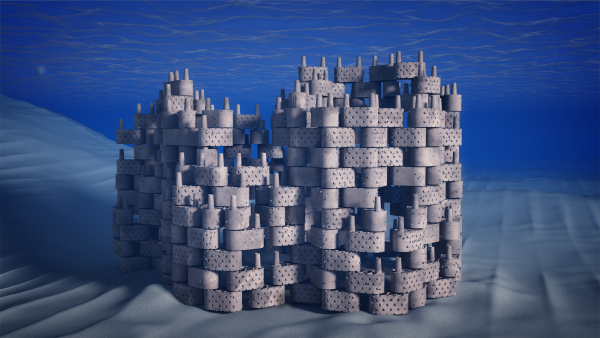
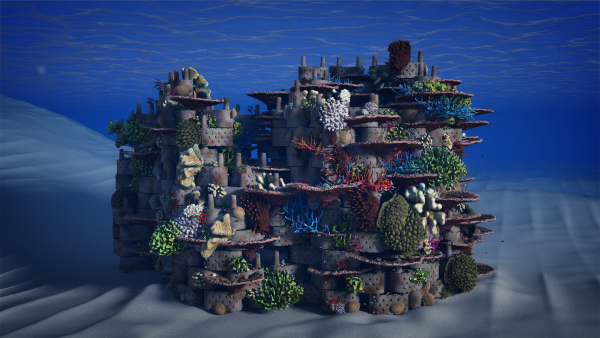
ETH Library Lab
The ETH Library Lab was established in 2018 as an initiative of the ETH Library and the library of the Karlsruhe Institute of Technology. It focuses on the future of academic libraries and new methods of knowledge transfer. The initiative is based on the concept of open science, which aims to make scientific output accessible to everyone. Twice a year, the ETH Library Lab invites Master’s students, artists and researchers to apply for an Innovator Fellowship and put their innovative concepts to the test. Marie Griesmar’s “Beneath the Sea” project improved the sharing of information on 3D printing in the library. Her models can now be found in the Material Archive run by Zurich University of the Arts and in the online database. You can find out more about working with clay and 3D printing on the Library Lab blog and on the ETH Library’s Explora website
This text has been published in the 20/04 issue of the Globe magazine.
Comments
No comments yet